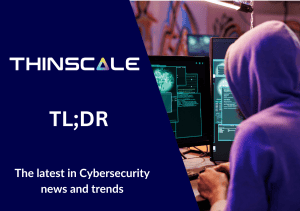Modern IT infrastructure is exposed to a large amount of risk, with the frequency of cyber-attack rising year on year. Hybrid working, which is becoming a mainstay for most organizations, increases the attack surface for organizations due to corporate accessing endpoints (e.g. laptops) moving outside of the organization’s direct control.
“Cybercrime, which includes everything from theft or embezzlement to data hacking and destruction, is up 600% as a result of the COVID-19 pandemic.” – Embroker.com, 2022
As a result, Zero Trust has become a vital framework to implement in modern IT environments, particularly for contact centers that handle sensitive customer data. In this article, we will be going through what Zero Trust is in relation to endpoints, what endpoint solutions are Zero Trust, and how ThinScale provides a true Zero Trust environment for contact centers.
What is Zero Trust?
Zero Trust is a security framework that requires all users to be authenticated, authorized, and validated on a consistent basis before allowing access to corporate resources and data. This framework applies to both those inside and outside the corporate network (on-premises or remote working). In Zero Trust frameworks there can be no point where the IT team relinquishes control. Regardless of location, or employee, these standards must be constantly maintained.
Zero Trust is ideally positioned to solve many challenges faced by the modern workforce, whether they be internal data leakage or external threats from malicious actors (ransomware attacks). The key factor in Zero Trust is in its name, all users, devices, and actions are assumed to be untrustworthy and capable of introducing a threat to the environment, whether maliciously or unintentionally.
Are all endpoint security solutions Zero Trust?
No, there are many endpoint security solutions on the market that do not meet these standards. Often they enforce security on one specific area of the IT stack, but they do not cover the whole spectrum of what is required by Zero Trust.
In order for a solution to be truly Zero Trust, it must follow these principles:
- Least Privilege Access
- Assume Breach
- Never trust, always verify
Least Privilege Access
This is the practice of restricting access rights for users, accounts, and even processes to only those specifically required for work. An example of this would be an agent who is restricted to accessing only the exact applications needed to carry out their work. The principle when applied to employees typically finds the lowest level of privileges that they can have and still carry out their role.
Least Privilege access also applies to IT processes and applications. IT teams need to make sure they are aware of the parent-child and background processes that are run by applications in their environment and restrict these so that only all non-business vital processes are blocked. In other words, malicious software is prevented from running in the first instance.
Breach Assumption
This is the concept of assuming your defenses have already been infiltrated and encourages you to take a stronger security posture. IT teams should take efforts to minimize the impact that this hypothetical breach should have. This is done by separating and segmenting access to corporate resources and thus reducing the organization’s overall attack surface. This along with end-to-end encryption and network monitoring will allow organizations to create a more secure environment.
Never Trust, Always Verify
The Zero Trust framework treats every user and interaction as a potential threat, both internal and external. If a solution is only protecting against malware but not against users launching unapproved local applications, then it is not Zero trust. Users and activity must be continuously verified. In Zero trust there are no trusted locations, devices, or users.
ThinScale – True zero trust for on-premises and remote environments.
ThinScale solutions are built with the principles and pillars of Zero Trust by design, working specifically to keep endpoints secure in dynamic hybrid and remote working environments. ThinScale solutions secure both corporately owned and BYOD machines, in the same way, applying the same restrictions regardless of location or device.
With ThinScale, devices are totally locked down inside encrypted workspace environments. Employees can only launch the applications specifically required for their work, alongside intelligent anti-malware rules in place, so users and corporate data are protected from both user-initiated and external risk.
Interested in learning more about how ThinScale can provide Zero-Trust endpoint environments? Get in touch with our team of experts below, we’ll be happy to help!



